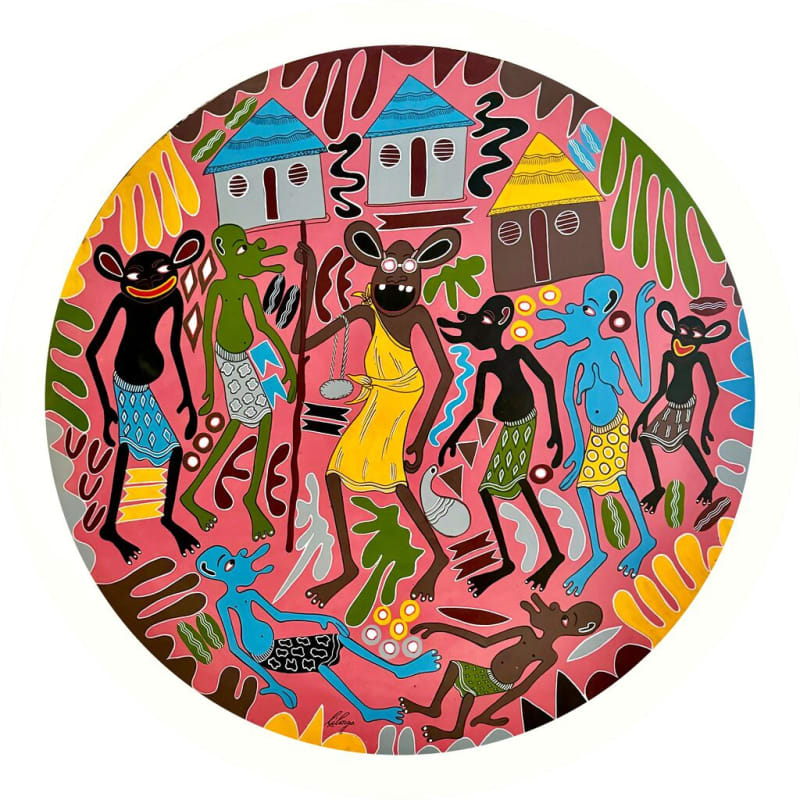Shetani, spirits and other stories: George Lilanga: The return of a forgotten genius
Twenty years after his passing, Black Liquid Art Gallery pays tribute to George Lilanga, one of the most iconic African artists, with an exhibition opening on February 15, 2025, celebrating his return.
Twenty years after his passing, Black Liquid Art Gallery pays tribute to George Lilanga, one of the most iconic African artists, with an exhibition opening on February 15, 2025, celebrating his return.
In 2011, Achille Bonito Oliva, in the exhibition Transafricana, reflected on contemporary African art, denouncing the way the West had often exploited it:“Africa has experienced an expropriation by the West, which, in the name of a presumed cultural superiority, has appropriated languages and symbols to revitalize an exhausted Western art.” He also highlighted how, in recent years, a more conscious and objective perspective had finally emerged: “We can finally look at contemporary African art with serenity, recognizing the awareness of these artists, once considered naïve, but today protagonists of a universal language.”
In today’s context, where contemporary African art has gained solid recognition both critically and in the market, the rediscovery of George Lilanga offers an opportunity to celebrate an artist who managed to take his imagery beyond Africa, creating global dialogues. His work not only maintained a deep connection with Makonde cultural roots but also contributed to defining a unique and recognizable identity matrix.
Born in 1934 in the village of Kikwetu, in Tanzania’s southern region, Lilanga belonged to the Makonde people, renowned for their wood sculpture and the mythological narratives linked to the Shetani, spirits embodying complex symbolisms of Makonde cosmology. From a young age, Lilanga immersed himself in art, learning ebony sculpture and developing an expressive language deeply rooted in tradition.
His move to Dar es Salaam in 1974 marked a decisive turning point in his career. At Nyumba ya Sanaa (House of Art), Lilanga found a creative environment that encouraged him to experiment beyond the boundaries of traditional sculpture. Here, his Shetani evolved: from three-dimensional figures, typical of traditional sculpture, they transformed into two-dimensional characters, animated by vibrant colors and dynamic lines. Lilanga’s canvases and masonites became a space where tradition and modernity intertwined, giving birth to a unique visual language accessible to a global audience.
Lilanga’s works celebrate cultural fusion, turning the Shetani into protagonists of contemporary narratives. In his compositions filled with multicolored Shetani, one perceives the artist’s ability to reinterpret the Makonde myth with irony and vitality. The dancing figures, with their sinuous and exaggerated bodies, not only capture the vibrancy of African communal life but also introduce a subtle satire on the human condition.
Lilanga participated in numerous international exhibitions in the 1980s and 1990s, from Magiciens de la Terre at the Centre Pompidou to Africa Remix, solidifying his reputation as one of the leading interpreters of contemporary African art. However, international success also brought economic speculation and cultural misunderstandings, which in some cases compromised the authentic perception of his work.
The exhibition organized by Black Liquid Art is not only a celebration of Lilanga’s work but also an opportunity to reflect on the meaning of tradition in today’s world. His artworks are not merely aesthetic testimonies but also documents of an ongoing dialogue between cultures, histories, and imaginations. Through his Shetani, Lilanga created a visual language capable of transcending geographical boundaries, capturing the essence of human experience with irony, depth, and vibrancy.
In a world where the boundaries between tradition and modernity are increasingly blurred, Lilanga invites us to celebrate hybridity as a value—to see in art not only a reflection of the past but also a means to understand the present and imagine the future.
